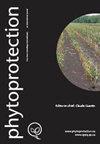Mortality and infection of wireworm, Agriotes obscurus [Coleoptera: Elateridae], with inundative field applications of Metarhizium anisopliae
IF 0.2
4区 农林科学
Q4 PLANT SCIENCES
引用次数: 38
Abstract
In an attempt to cause fatal infection of wireworm Agriotes obscurus [Coleoptera: Elateridae], Metarhizium anisopliae was applied in the field as factorial combinations of conidia formulated as granules at 3.68 g granules or 1.25 x 1010 cfu per 196 cm2 (6.38 x 107 conidia cm-2), as conidia mixed with soil at 1.26 x 1010 cfu per 2.986 cm3 soil (4.22 x 106 conidia cm-3 soil), and as conidia-coated wheat seed (100 wheat seeds or 4.16 x 109 cfu per 196 cm2 = 2.12 x 107 conidia cm-2). The treatments resulted in a significantly greater number of mycosed wireworms compared with the control over and during five sampling periods. Significant differences in total wireworm mortality and mycosed wireworms in the field occurred at any time ranging from 15 to 82 d following treatment. The treatments also caused a reduction in the number of wireworms found in the cores, implying that they had a repellent effect. Latent infection of wireworms became apparent after living wireworms from the field treatments died following incubation under laboratory conditions, in numbers significantly greater than the control. This study showed that M. anisopliae can be applied in the field and infect and kill wireworms, but only at concentrations exceeding 4 x 106 conidia cm-3 with the subject isolate, wireworm species, and field conditions used in this study.金龟子绿僵菌田间大面积应用对黑线线虫死亡率和感染的影响
为了引起致命的感染铁线虫Agriotes obscurus(鞘翅目:叩头虫科),绿僵菌属anisopliae应用领域一样的阶乘的分生孢子组合制定颗粒在3.68 g颗粒或1.25 x 1010 cfu / 196 cm2 (6.38 x 107分生孢子cm-2),混合了分生孢子与土壤为1.26 x 1010 cfu / 2.986立方厘米(4.22 x 106分生孢子cm-3土壤),以及conidia-coated小麦种子(100小麦种子或4.16 x 109 cfu / 196 cm2 = 2.12 x 107分生孢子cm-2)。在5个采样周期内,与对照相比,这些处理导致真菌线虫的数量显著增加。在处理后15至82 d的任何时间,田间线虫的总死亡率和霉变线虫的死亡率都有显著差异。这些处理还导致在核心中发现的线虫数量减少,这意味着它们具有驱避作用。现场处理的活线虫在实验室条件下孵育后死亡,其数量明显高于对照,潜伏感染变得明显。本研究表明,在本研究使用的分离物、线虫种类和田间条件下,绿僵菌仅在浓度超过4 × 106分生孢子cm-3的情况下才能在田间应用并感染和杀死线虫。
本文章由计算机程序翻译,如有差异,请以英文原文为准。
求助全文
约1分钟内获得全文
求助全文

 求助内容:
求助内容: 应助结果提醒方式:
应助结果提醒方式:


